Technique - Investigating discolouration of Blinq88 PE6060 4000K LED-panel
LED-panels: a huge advance
With the necessity to get the energy-consumption down, LED-technique went through major improvements over the 2010-2019 decade, be it only after some political pressure. Probably the most important evolution is the LED-panel and its very uniform radiation pattern compared to its predecessor: the fixture with fluorescent tubes.
The company I was working at in 2016, decided to convert the lighting in the first offices. Though I am not so fond of the light-distribution of this panel compared to the V-TAC panel elsewhere on this site, these do what they are supposed to do.
Very apparent discolouration in a few panels
 In 2020 I was asked to exchange a few panels with new ones because of severe discolouration.
In 2020 I was asked to exchange a few panels with new ones because of severe discolouration.
I found that strange, because what was causing the discolouration?
Besides that, it was just 1 panel in every room mentioned. Because both offices used multiples of the same panels, I got curious.
Both panels clearly showed the difference in lightcolour. The two panels that took care of the night-lighting (and thus were on all day, every day for the last 4 years) had become seriously yellow.
That's why I first thought about the LEDs itself.
I exchanged the panels and kept them separated from the workflow, to inspect them after working hours.
Let's investigate
Switched off the discolouration can not be seen and you can't distinguish a good unit from a bad one. Because the plate you see the first is a diffuser, I was left with 3 possible causes: the lightguide, the LEDs itself, or the reflectorplate.
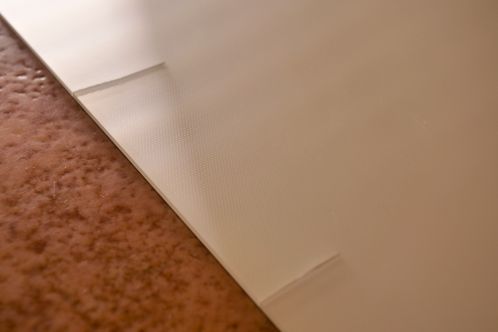 I removed the screws that hold the backplate, removed the foam that presses everything together and saw a reflectorplate in good order. But after lifting it, I saw the lightguide and it was showing obvious discolouration, something that got even more evident with the LEDs lighted.
I removed the screws that hold the backplate, removed the foam that presses everything together and saw a reflectorplate in good order. But after lifting it, I saw the lightguide and it was showing obvious discolouration, something that got even more evident with the LEDs lighted.
To take a look right through the lightguide, I wanted to lift it from the frame. Even though my approach was very gentle, some weird bangs were heard and cracks appeared in the acrylic plate.
The lightguide had suffered some severe degradation!
The cause: UV-rays?
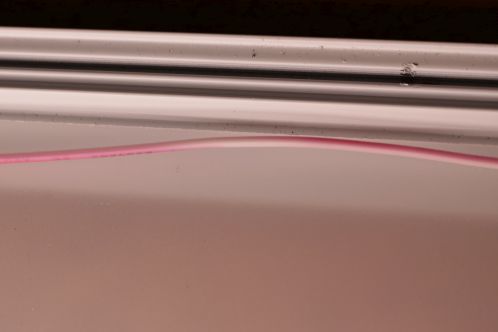 I know that acrylic products can weather when they endure UV-rays, so this was my first gamble. But that did not explain why the many other panels in the same office-space were still in good condition, while many of them were far closer to windows than the discoloured panel and one of the rooms even hardly saw any daylight at all.
I know that acrylic products can weather when they endure UV-rays, so this was my first gamble. But that did not explain why the many other panels in the same office-space were still in good condition, while many of them were far closer to windows than the discoloured panel and one of the rooms even hardly saw any daylight at all.
That's why I could only think that the LEDs themselves were emitting UV-rays. These panels were always switched on, so possible UV-degredation by LED-emission would have the worst outcome on these panels.
Near the LEDstrips' I saw weird, almost white wires running along the sides of the panel. When investigating this further, these wires proved to be red by origin, but had almost completely become discoloured at the spots where LED-light could reach them. This solidified my thoughts that the LEDs used output quite some UV-rays, leading to discolouration of the light guide plate.
Light guide technology
As disposal seemed the only possible option, I decided to look if I could get the light guide plates myself. In videolights this technology had also made its appearance, but I never managed to find the light guide plates to buy myself.
Dutch companies just don't deliver to private customers, it's as simple as that. Besides their companies-only policies, they usually required a minimum order quantity of 20 to 25 pieces. Understandable, but not fun.
Via a distributor of plastics in the USA who díd deliver to private customers, I got to the original manufacturers' website, Jungbecker.
After sending a message on the website of Jungbecker, I got the data to get in touch with the sales-department (Intertek Trading AG). Though they usually did not deliver to private customers, they would just send my order in as a request for samples.
To make a long story short: I ordered two light-guide plates. Financially, it's not interesting at all, I'll just give it to you like that. Bigger orders (or start negotiating at a lower price) could possibly help.
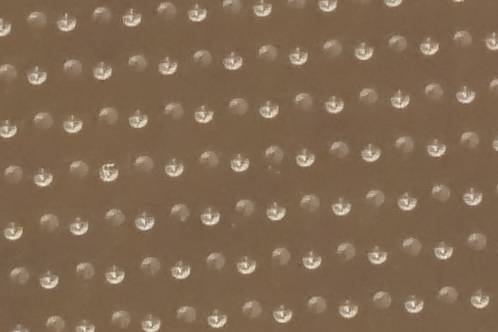 Evenso, it's very interesting technology to get your hands on. Interesting, but also very vulnerable technology. The plates are wrapped in a special kind of cloth and the plates are only to be handled wearing special gloves. I didn't have those, but an unused, huge cloth to clean eyeglasses with worked out quite right.
Evenso, it's very interesting technology to get your hands on. Interesting, but also very vulnerable technology. The plates are wrapped in a special kind of cloth and the plates are only to be handled wearing special gloves. I didn't have those, but an unused, huge cloth to clean eyeglasses with worked out quite right.
The downside is that this stuff gets insanely charged with static electricity. Keeping the plates dustfree - like strongly recommended in the manual - is not doable as a consumer/hobbyist.
These acrylic sheets are called 'First Virgin' acrylic. I had to search what it meant.
Most importantly, this is not recycled acrylic. It's the most pure acrylic product you can get and is the most resistant against fracturing and other mechanical damage.
Surprising detail: recycled acrylic has a worse light-throughput and is more susceptible to - here it comes - turning yellow due to UV-radiation and the accompanied risk of mechanical damage (fracturing/tearing).
Such light guide plates, called LGP from now on, are available in multiple variants to break the light and reflect it:
- with grooves
- with lasered pits
- with a combination of grooves and lasered pits
The advantages of plates with grooves are most likely down to costs. Light-wise I could not find any difference between the original plates from the Blinq88 panels (with grooves) and the plates with pits I ordered.
Each panel its own LGP
An important detail is that the breaking of the light for a large part depends on the LEDs used and the number of sides they radiate into. Exchanging the LGP from a totally different panel could lead to bad results as the pattern of pits has been optimised based on the distance between the LEDs and the number of them over a specified length.
Besides that, it also matters if the panel is lit from two opposing sides, or from all four.
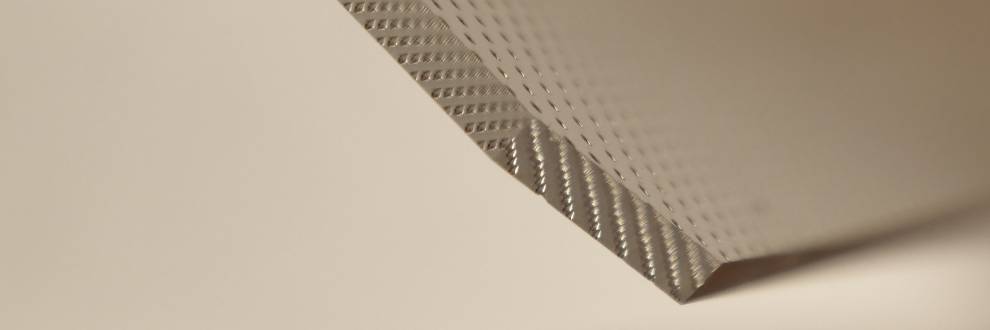
The pattern of pits is, even though they are remarkably shallow, hard to miss when you view the plate from one of the sides. It's a mesmerizing effect to see the endless reflections and rows of pits.
In practice
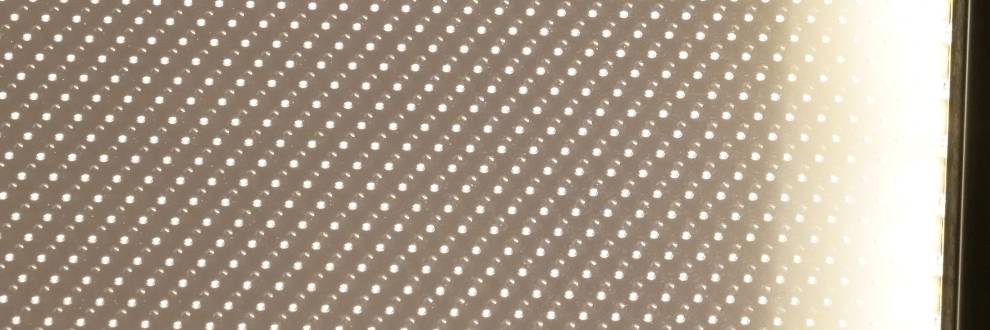
It's fascinating to see that when lighted, also in the middle of the plate, the pits still do their job, while you would expect that all light had been blocked by the pits near the sides of the plate.
Comparing old and new
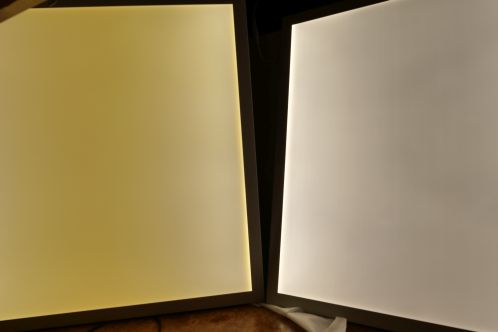 Switched on, the difference between both panels really shows, even though the picture probably doesn't do it justice due to compression and (I suspect) the background color of my website.
Switched on, the difference between both panels really shows, even though the picture probably doesn't do it justice due to compression and (I suspect) the background color of my website.
Besides the better colour the light-intensity also got boosted due to the new LGP. The light colour does seem a bit warmer than 4000K, but the LEDs did already last for 35000 hours. Aging than really starts to play a part. As can be seen, it's not as evenly lit as my other panel.
Even though the price isn't interesting, it's very interesting technology to see from up close.